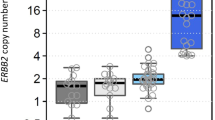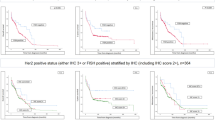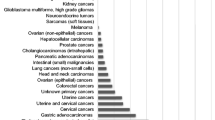Abstract
Background HER2 gene amplification and/or protein overexpression in breast cancer is associated with a poor prognosis and predicts response to anti-HER2 therapy. We examine the natural history of breast cancers in relationship to increased HER2 copy numbers in a large population-based study. Patients and Methods HER2 status was measured by fluorescence in situ hybridization (FISH) and immunohistochemistry (IHC) in approximately 1,400 breast cancer cases with greater than 15 years of follow-up. Protein expression was evaluated with two different commercially-available antibodies. Results We looked for subgroups of breast cancer with different clinical outcomes, based on HER2 FISH amplification ratio. The current HER2 ratio cut point for classifying HER2 positive and negative cases is 2.2. However, we found an increased risk of disease-specific death associated with FISH ratios of >1.5. An ‘intermediate’ group of cases with HER2 ratios between 1.5 and 2.2 was found to have a significantly better outcome than the conventional ‘amplified’ group (HER2 ratio >2.2) but a significantly worse outcome than groups with FISH ratios less than 1.5. Conclusion Breast cancers with increased HER2 copy numbers (low level HER2 amplification), below the currently accepted positive threshold ratio of 2.2, showed a distinct, intermediate outcome when compared to HER2 unamplified tumors and tumors with HER2 ratios greater than 2.2. These findings suggest that a new cut point to determine HER2 positivity, at a ratio of 1.5 (well below the current recommended cut point of 2.2), should be evaluated.




Similar content being viewed by others
References
Slamon DJ, Clark GM, Wong SG, Levin WJ, Ullrich A, McGuire WL (1987) Human breast cancer: correlation of relapse and survival with amplification of the HER-2/neu oncogene. Science 235(4785):177–182
Slamon DJ, Godolphin W, Jones LA, Holt JA, Wong SG, Keith DE, Levin WJ, Stuart SG, Udove J, Ullrich A et al (1989) Studies of the HER-2/neu proto-oncogene in human breast and ovarian cancer. Science 244(4905):707–712
Cobleigh MA, Vogel CL, Tripathy D, Robert NJ, Scholl S, Fehrenbacher L, Wolter JM, Paton V, Shak S, Lieberman G et al (1999) Multinational study of the efficacy and safety of humanized anti-HER2 monoclonal antibody in women who have HER2-overexpressing metastatic breast cancer that has progressed after chemotherapy for metastatic disease. J Clin Oncol 17(9):2639–2648
Joensuu H, Kellokumpu-Lehtinen PL, Bono P, Alanko T, Kataja V, Asola R, Utriainen T, Kokko R, Hemminki A, Tarkkanen M et al (2006) Adjuvant docetaxel or vinorelbine with or without trastuzumab for breast cancer. N Engl J Med 354(8):809–820
Piccart-Gebhart MJ, Procter M, Leyland-Jones B, Goldhirsch A, Untch M, Smith I, Gianni L, Baselga J, Bell R, Jackisch C et al (2005) Trastuzumab after adjuvant chemotherapy in HER2-positive breast cancer. N Engl J Med 353(16):1659–1672
Romond EH, Perez EA, Bryant J, Suman VJ, Geyer CE Jr, Davidson NE, Tan-Chiu E, Martino S, Paik S, Kaufman PA et al (2005) Trastuzumab plus adjuvant chemotherapy for operable HER2-positive breast cancer. N Engl J Med 353(16):1673–1684
Slamon DJ, Leyland-Jones B, Shak S, Fuchs H, Paton V, Bajamonde A, Fleming T, Eiermann W, Wolter J, Pegram M et al (2001) Use of chemotherapy plus a monoclonal antibody against HER2 for metastatic breast cancer that overexpresses HER2. N Engl J Med 344(11):783–792
Vogel CL, Cobleigh MA, Tripathy D, Gutheil JC, Harris LN, Fehrenbacher L, Slamon DJ, Murphy M, Novotny WF, Burchmore M et al (2002) Efficacy and safety of trastuzumab as a single agent in first-line treatment of HER2-overexpressing metastatic breast cancer. J Clin Oncol 20(3):719–726
Wolff AC, Hammond ME, Schwartz JN, Hagerty KL, Allred DC, Cote RJ, Dowsett M, Fitzgibbons PL, Hanna WM, Langer A et al (2007) American Society of Clinical Oncology/College of American Pathologists guideline recommendations for human epidermal growth factor receptor 2 testing in breast cancer. Arch Pathol Lab Med 131(1):18
Wolff AC, Hammond ME, Schwartz JN, Hagerty KL, Allred DC, Cote RJ, Dowsett M, Fitzgibbons PL, Hanna WM, Langer A et al (2007) American Society of Clinical Oncology/College of American Pathologists guideline recommendations for human epidermal growth factor receptor 2 testing in breast cancer. J Clin Oncol 25(1):118–145
Paik S, Kim C, Jeong J, Geyer CE, Romond EH, Mejia-Mejia O, Mamounas EP, Wickerham D, Costantino JP, Wolmark N (2007) Benefit from adjuvant trastuzumab may not be confined to patients with IHC 3+ and/or FISH-positive tumors: Central testing results from NSABP B-31. J Clin Oncol, 2007 ASCO Annual Meeting Proceedings Part I Vol 25(No. 18S (June 20 Supplement), 2007):511
Perez EA, Romond EH, Suman VJ, Jeong J, Davidson NE, Geyer CE, Martino S, Mamounas EP, Kauffman PA, Wolmark N et al (2007) Updated results of the combined analysis of NCCTG N9831 and NSABP B-31 adjuvant chemotherapy with/without trastuzumab in patients with HER2-positive breast cancer. J Clin Oncol, 2007 ASCO Annual Meeting Proceedings Part I. Vol 25(No. 18S (June 20 Supplement)):512
Cheang MC, Treaba DO, Speers CH, Olivotto IA, Bajdik CD, Chia SK, Goldstein LC, Gelmon KA, Huntsman D, Gilks CB et al (2006) Immunohistochemical detection using the new rabbit monoclonal antibody SP1 of estrogen receptor in breast cancer is superior to mouse monoclonal antibody 1D5 in predicting survival. J Clin Oncol 24(36):5637–5644
Chia SK, Speers CH, Bryce CJ, Hayes MM, Olivotto IA (2004) Ten-year outcomes in a population-based cohort of node-negative, lymphatic, and vascular invasion-negative early breast cancers without adjuvant systemic therapies. J Clin Oncol 22(9):1630–1637
Lohrisch C, Jackson J, Jones A, Mates D, Olivotto IA (2000) Relationship between tumor location and relapse in 6,781 women with early invasive breast cancer. J Clin Oncol 18(15):2828–2835
Olivotto A, Coldman AJ, Hislop TG, Trevisan CH, Kula J, Goel V, Sawka C (1997) Compliance with practice guidelines for node-negative breast cancer. J Clin Oncol 15(1):216–222
Olivotto IA, Bajdik CD, Ravdin PM, Speers CH, Coldman AJ, Norris BD, Davis GJ, Chia SK, Gelmon KA (2005) Population-based validation of the prognostic model ADJUVANT! for early breast cancer. J Clin Oncol 23(12):2716–2725
Shek LL, Godolphin W (1988) Model for breast cancer survival: relative prognostic roles of axillary nodal status, TNM stage, estrogen receptor concentration, and tumor necrosis. Cancer Res 48(19):5565–5569
Shek LL, Godolphin W (1989) Survival with breast cancer: the importance of estrogen receptor quantity. Eur J Cancer Clin Oncol 25(2):243–250
Shek LL, Godolphin W, Spinelli JJ (1987) Oestrogen receptors, nodes and stage as predictors of post-recurrence survival in 457 breast cancer patients. Br J Cancer 56(6):825–829
Turbin DA, Leung S, Cheang MC, Kennecke HA, Montgomery KD, McKinney S, Treaba DO, Boyd N, Goldstein LC, Badve S et al (2007) Automated quantitative analysis of estrogen receptor expression in breast carcinoma does not differ from expert pathologist scoring: a tissue microarray study of 3,484 cases. Breast Cancer Res Treat. doi:10.1007/s10549-007-9736-z
Kononen J, Bubendorf L, Kallioniemi A, Barlund M, Schraml P, Leighton S, Torhorst J, Mihatsch MJ, Sauter G, Kallioniemi OP (1998) Tissue microarrays for high-throughput molecular profiling of tumor specimens. Nat Med 4(7):844–847
Parker RL, Huntsman DG, Lesack DW, Cupples JB, Grant DR, Akbari M, Gilks CB (2002) Assessment of interlaboratory variation in the immunohistochemical determination of estrogen receptor status using a breast cancer tissue microarray. Am J Clin Pathol 117(5):723–728
Brown LA, Huntsman D (2007) Fluorescent in situ hybridization on tissue microarrays: challenges and solutions. J Mol Histol 38(2):151–157
Hastie T, Tibshirani R (1990) Generalized additive models. New York: Chapman & Hall
Kalbfleisch JD, Prentice RL (2002) The statistical analysis of failure time data. Hoboken: John Wiley and Sons
Pauletti G, Dandekar S, Rong H, Ramos L, Peng H, Seshadri R, Slamon DJ (2000) Assessment of methods for tissue-based detection of the HER-2/neu alteration in human breast cancer: a direct comparison of fluorescence in situ hybridization and immunohistochemistry. J Clin Oncol 18(21):3651–3664
Dal Lago L, Durbecq V, Desmedt C, Salgado R, Verjat T, Lespagnard L, Ma Y, Veys I, Di Leo A, Sotiriou C et al (2006) Correction for chromosome-17 is critical for the determination of true Her-2/neu gene amplification status in breast cancer. Mol Cancer Ther 5(10):2572–2579
Jimenez RE, Wallis T, Tabasczka P, Visscher DW (2000) Determination of Her-2/Neu status in breast carcinoma: comparative analysis of immunohistochemistry and fluorescent in situ hybridization. Mod Pathol 13(1):37–45
Nielsen TO, Hsu FD, Jensen K, Cheang M, Karaca G, Hu Z, Hernandez-Boussard T, Livasy C, Cowan D, Dressler L et al (2004) Immunohistochemical and clinical characterization of the basal-like subtype of invasive breast carcinoma. Clin Cancer Res 10(16):5367–5374
Sorlie T, Perou CM, Tibshirani R, Aas T, Geisler S, Johnsen H, Hastie T, Eisen MB, van de Rijn M, Jeffrey SS et al (2001) Gene expression patterns of breast carcinomas distinguish tumor subclasses with clinical implications. Proc Natl Acad Sci USA 98(19):10869–10874
Perou CM, Sorlie T, Eisen MB, van de Rijn M, Jeffrey SS, Rees CA, Pollack JR, Ross DT, Johnsen H, Akslen LA et al (2000) Molecular portraits of human breast tumours. Nature 406(6797):747–752
Pollack JR, Perou CM, Alizadeh AA, Eisen MB, Pergamenschikov A, Williams CF, Jeffrey SS, Botstein D, Brown PO (1999) Genome-wide analysis of DNA copy-number changes using cDNA microarrays. Nat Genet 23(1):41–46
Acknowledgements
The British Columbia tissue microarray cohort was developed using funds from a Canadian Breast Cancer Research Alliance Translational Acceleration Grant along with an unrestricted education grant from sanofi-aventis Canada. The HER2 FISH analysis was funded in part by an educational grant from Roche Canada.
Author information
Authors and Affiliations
Corresponding authors
Electronic supplementary material
10549_2007_9887_MOESM1_ESM.pdf
Supplemental Figure 1. Proportional hazard for variable cut points comparing P-value and HER2 amplification ratio (PDF 14 kb)
10549_2007_9887_MOESM2_ESM.pdf
Supplemental Figure 2. Heatmap of likelihood values as varying with lower and higher HER2 FISH ratio cut points (PDF 26 kb)
Rights and permissions
About this article
Cite this article
Jensen, K.C., Turbin, D.A., Leung, S. et al. New cutpoints to identify increased HER2 copy number: analysis of a large, population-based cohort with long-term follow-up. Breast Cancer Res Treat 112, 453–459 (2008). https://doi.org/10.1007/s10549-007-9887-y
Received:
Accepted:
Published:
Issue Date:
DOI: https://doi.org/10.1007/s10549-007-9887-y




